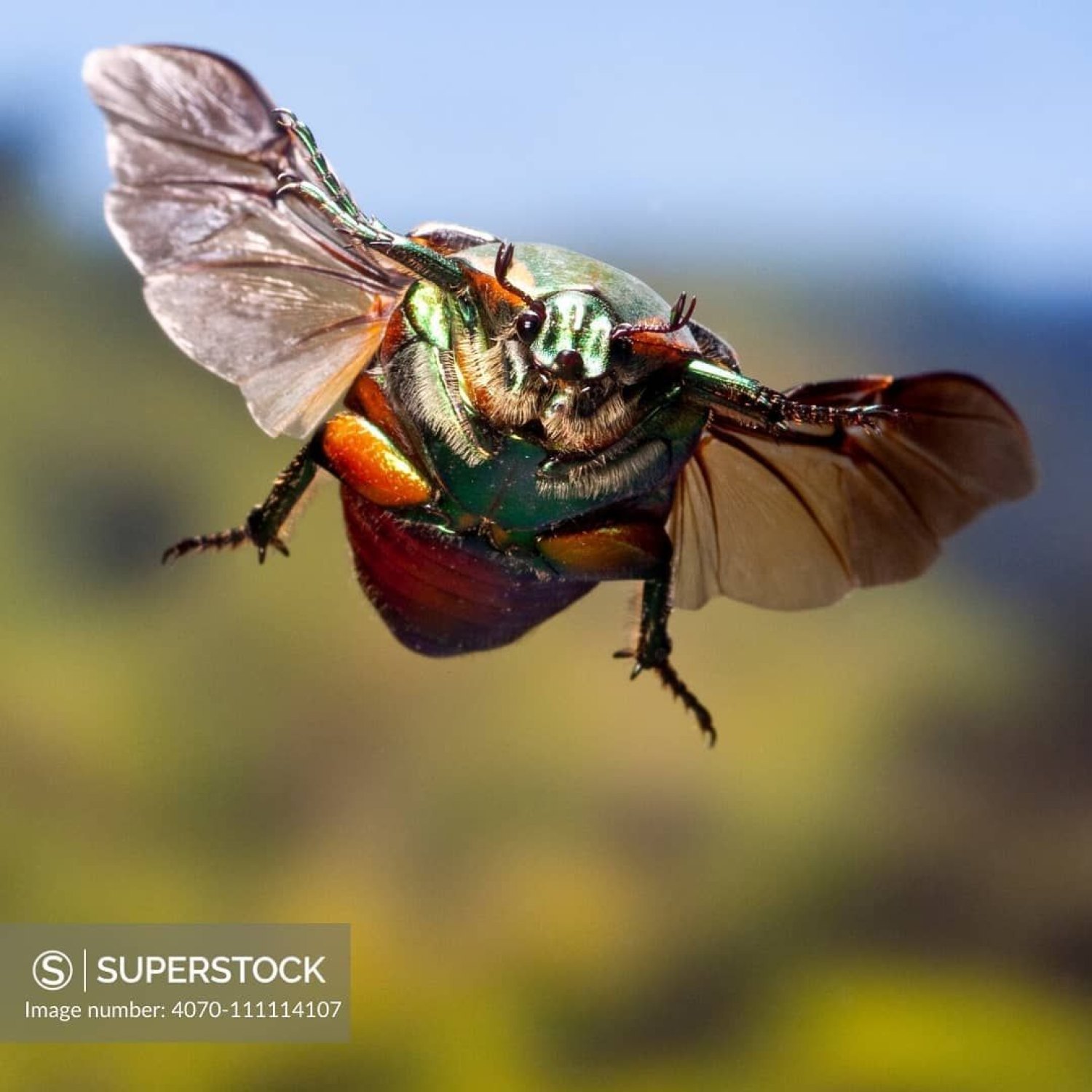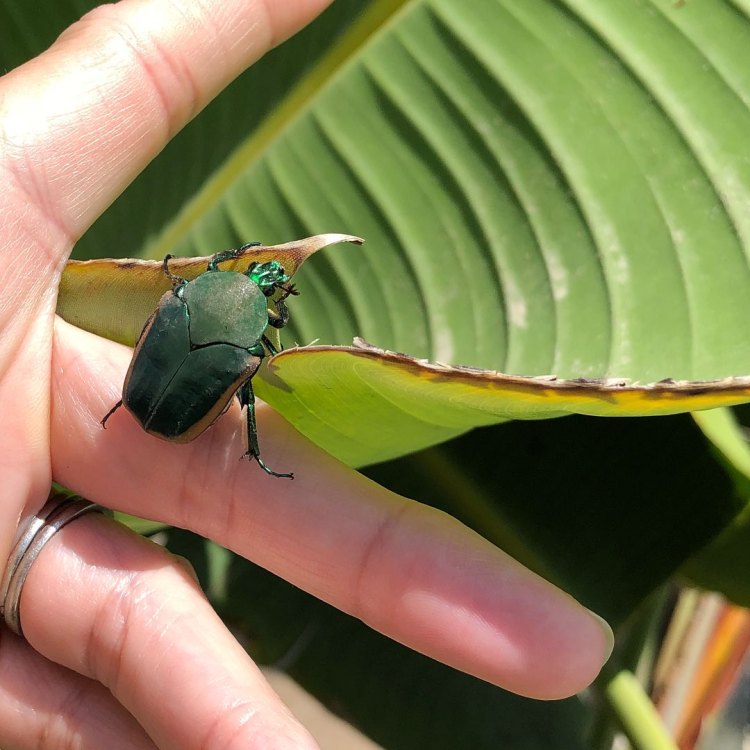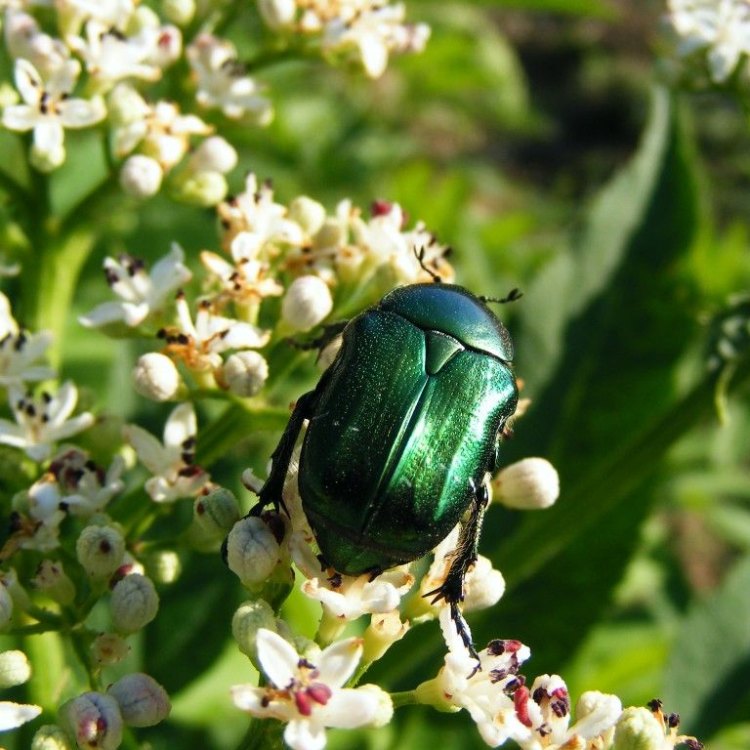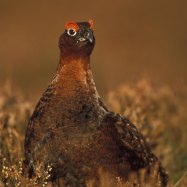
Green June Beetle
1-1.5 inches
The Green June Beetle, also known as Cotinis nitida, is a beautiful creature found in the eastern and central United States. With a body length of 1-1.5 inches and an oval shape, they belong to the Scarabaeidae family. These vibrant green beetles are a delight to see in gardens and are known for their strong flight capabilities. Keep an eye out for them next time you're exploring the outdoors! #GreenJuneBeetle #Scarabaeidae #EasternUS #CentralUS
Animal Details Summary:
Common Name: Green June Beetle
Kingdom: Animalia
Habitat: Woodlands, grasslands, and gardens
The Stunning Green June Beetle: A Jewel of the Skies
The world is full of beautiful creatures, each with its unique colors, shapes, and behaviors. Among these, the Green June Beetle (Cotinis nitida) stands out as a stunning jewel of the skies.This magnificent insect belongs to the Animalia kingdom, Phylum Arthropoda, and Class Insecta. It is a member of the Coleoptera order and the Scarabaeidae family Green June Beetle. Its common name, Green June Beetle, is derived from its striking color and the time of the year when it is most active - June.
Green June Beetles can be found in woodlands, grasslands, and gardens, making them a familiar sight for many outdoor enthusiasts. They are mostly found in North America, with the United States being their country of origin. Specifically, they are commonly seen in the eastern and central regions of the United States.
One of the most striking features of the Green June Beetle is its shiny metallic green color, which gives it a mesmerizing appearance. This coloration is what makes it stand out from other beetles in the same family. The beetle's oval-shaped body adds to its aesthetic appeal, making it a sight to behold.
On average, the Green June Beetle measures between 1 to 1.5 inches in length, making it a relatively large insect Golden Crowned Kinglet. Despite its size, it is considered a gentle creature, and there is no need to fear it.
##The Life of a Green June Beetle
Like all insects, Green June Beetles undergo complete metamorphosis, meaning they go through four distinct life stages - egg, larva, pupa, and adult. As mentioned earlier, they are most active in June, where they emerge from their pupae as adults.
The adults are diurnal, meaning they are active during the day, and they can fly short distances. Their preferred habitats include open areas with plenty of vegetation, such as gardens and fields. They are also attracted to lights and can often be found crawling around porch lights at night.
Green June Beetles are not picky eaters, and they have a variety of food sources to choose from. As adults, they commonly feed on flowers, fruits, and tree sap, making them important pollinators in their habitats. On the other hand, the larvae feed on decaying plant matter, playing a crucial role in nutrient cycling.
##A Valuable Member of the Ecosystem
Green June Beetles may not get the same attention or recognition as other insects like butterflies or ladybugs, but they play a vital role in their ecosystems.
As mentioned earlier, their larvae play a crucial role in breaking down decaying organic matter, allowing important nutrients to return to the soil. In this way, they contribute to the overall health of their habitats.
Moreover, as pollinators, Green June Beetles help in the reproduction of flowering plants, ensuring a steady food supply for other insects, birds, and animals. They are known to be particularly attracted to flowering plants such as roses, blackberries, and peonies.
##Threats and Conservation Efforts
Green June Beetles face threats in the form of habitat loss and degradation due to human activities such as urbanization and agriculture. They are also affected by pesticides, which are intended to control other insect pests but can also harm non-target species.
Thankfully, the Green June Beetle is not considered endangered, and its population is stable. This is due to its wide distribution and adaptability to different environments. However, it is essential to continue monitoring their populations and advocating for the conservation of their habitats.
##Fascinating Facts about the Green June Beetle
- The Green June Beetle's scientific name, Cotinis nitida, is derived from two Latin words; cotinus, meaning "shiny," and nitida, meaning "clean and bright."
- Green June Beetles have strong jaws and can inflict a painful bite if handled aggressively. However, they are not aggressive and only bite if they feel threatened.
- They can produce a high-pitched buzzing sound when in flight, similar to that of a bumblebee.
- They are also known as the figeater beetle, May beetle, and June bug – all of which are misleading because they are not restricted to only June and do not exclusively feed on figs.
- In some cultures, Green June Beetles are considered good luck, and some people keep them as pets or use them in traditional medicine.
##The Future of the Green June Beetle
As our world continues to change, it is crucial to appreciate and conserve all forms of life, including the Green June Beetle. By understanding and sharing knowledge about this beautiful insect, we can help in its conservation efforts.
Moreover, as we embrace sustainable practices and reduce our impact on the environment, we can ensure the future of many species, including the Green June Beetle.
In conclusion, the Green June Beetle is more than just a shiny green insect; it is a valuable member of its ecosystem, playing a vital role in its survival. So, the next time you come across one of these stunning creatures, take a moment to appreciate its beauty and contribution to the natural world.

Green June Beetle
Animal Details Green June Beetle - Scientific Name: Cotinis nitida
- Category: Animals G
- Scientific Name: Cotinis nitida
- Common Name: Green June Beetle
- Kingdom: Animalia
- Phylum: Arthropoda
- Class: Insecta
- Order: Coleoptera
- Family: Scarabaeidae
- Habitat: Woodlands, grasslands, and gardens
- Feeding Method: Adults feed on flowers, fruits, and tree sap. Larvae feed on decaying plant matter.
- Geographical Distribution: North America
- Country of Origin: United States
- Location: Eastern and central United States
- Animal Coloration: Shiny metallic green
- Body Shape: Oval-shaped
- Length: 1-1.5 inches

Green June Beetle
- Adult Size: Medium-sized
- Average Lifespan: 1-2 years
- Reproduction: Sexual
- Reproductive Behavior: Males attract females with a buzzing sound and perform aerial displays.
- Sound or Call: Males produce a buzzing sound during flight.
- Migration Pattern: Non-migratory
- Social Groups: Solitary
- Behavior: Nocturnal and attracted to lights
- Threats: Loss of habitat, pesticides
- Conservation Status: Not evaluated
- Impact on Ecosystem: Play a role in pollination and nutrient recycling
- Human Use: Not commonly used by humans
- Distinctive Features: Metallic green color, large size, buzzing sound
- Interesting Facts: The Green June Beetle gets its name from its tendency to be most active during the month of June. They are known for their loud buzzing sound and are often attracted to lights at night.
- Predator: Birds, small mammals

Cotinis nitida
The Green June Beetle: A Hidden Jewel in Our Ecosystem
In the midst of a lush green garden, you may have spotted a shiny, metallic green beetle known as the Green June Beetle. Upon closer observation, you may have been fascinated by the distinct buzzing sound it makes as it flies around. This medium-sized beetle, with an average lifespan of 1-2 years, might seem like just another insect in nature. However, the Green June Beetle has unique characteristics and plays an important role in our ecosystem PeaceOfAnimals.Com.Reproduction is a crucial aspect of any species' survival, and the Green June Beetle is no exception. Their reproductive behavior is sexual, meaning that males and females must come together to mate. Interestingly, male Green June Beetles have a special way of attracting females. They produce a distinct buzzing sound during flight, which acts as a call to potential mates. Not only that, but male Green June Beetles also perform aerial displays to impress female beetles. Talk about putting in effort to find love!
The buzzing sound that male Green June Beetles produce is also known as a 'call'. This behavior is known as acoustic communication, and it helps in the mating process by attracting females. The call of the Green June Beetle is unique and can be easily distinguished from other insect noises. You may have even mistaken it for a bee or a hummingbird initially, but upon closer inspection, you'll realize it's the Green June Beetle trying to find its mate Garden Eel.
While many species of birds and insects migrate to different areas for various reasons, the Green June Beetle is non-migratory. This means they do not travel to other areas and prefer to stay in a particular region. Often, they can be found in agricultural fields, forests, and gardens, where their primary food sources are found.
However, despite their preference for solitary living, there is one behavior that brings them together – nocturnal activity. The Green June Beetle is predominantly a nocturnal insect, meaning they are most active during the night. They are attracted to lights and can often be seen fluttering around porch lights and street lamps.
Although the Green June Beetle has no specific predators, birds and small mammals may occasionally prey on them. However, the biggest threat to their population is the loss of habitat and the use of pesticides. With urbanization and the increase in the use of pesticides, the Green June Beetle's natural habitat is quickly diminishing. Their primary food sources, including fruits, plants, and decaying matter, are also affected, making it difficult for them to survive.
Unfortunately, the conservation status of the Green June Beetle is not evaluated, which means there is not enough data to determine their population and potential endangerment. However, it is essential to take measures to protect and preserve their habitat to ensure their existence in the future.
While the Green June Beetle may not be as well-known or commonly used by humans, they still play a significant role in our ecosystem. As pollinators, they aid in the reproduction of plants by carrying pollen from one flower to another. They also contribute to nutrient recycling by feeding on decaying matter, which helps fertilize and enrich the soil.
The Green June Beetle's distinctive features make it stand out from other insects, making it a hidden jewel in our ecosystem. The metallic green color of their shiny exoskeleton is a sight to behold, and their large size gives them a grand presence. But perhaps their most interesting feature is their buzzing sound, which is what gives them their name – the Green June Beetle. They are most active during the month of June, hence the name, and are known for their loud buzzing sound, making them a unique and fascinating species to observe.
In conclusion, the Green June Beetle may seem like just another insect, but it has unique characteristics and plays a crucial role in our ecosystem. As a species that is often overlooked and not evaluated, it is vital to raise awareness and take measures to protect and preserve their habitat. The next time you come across a shiny, metallic green beetle with a distinct buzzing sound, remember the Green June Beetle and appreciate its significance in our ecosystem.

The Stunning Green June Beetle: A Jewel of the Skies
Disclaimer: The content provided is for informational purposes only. We cannot guarantee the accuracy of the information on this page 100%. All information provided here may change without prior notice.












